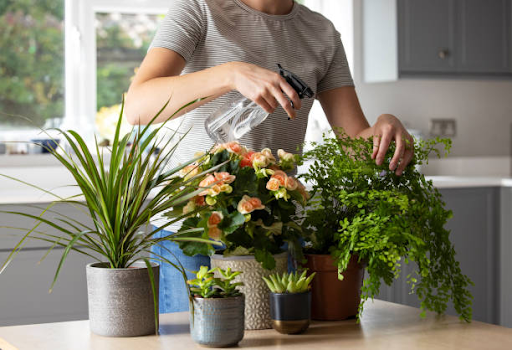Having a good grasp of how to braid your own hair can be incredibly useful. It can help you keep your hair out of your face on a hot day, easily create a cute and stylish look, and keep your hair looking neat and tamed. If you’re a beginner in hair braiding, this blog is for you. Here’s a beginner’s guide to braiding your own hair.
First, you’ll need to determine which type of braid you want to create. Common types of braids include French braids, cornrows, Dutch braids, fishtail braids, waterfall braids, and more. Research different braids on the internet and try to find diagrams and tutorials to help you understand which type of braid you’d like to do.
Once you’ve decided on a braid, it’s time to get everything you’ll need. Typical tools you may need include a brush, hair elastics, hair clips, and sometimes even bobby pins or hairspray. Make sure you have all these tools nearby.
Now it’s time for the actual braiding. Start by brushing your hair to get rid of any tangles, and then separate your hair into manageable strands. Depending on the braid you’re attempting to create, the number of strands should vary from three to six strands. Make sure each strand is even before you start braiding.
Start braiding your hair by beginning at the base of your scalp and taking a top strand to cross it over the middle one. Then take a strand from the bottom and cross it over the middle. Repeat this process with the remaining strands until you reach the bottom of your hair. Secure the end of your braided hair with a hair elastic.
Finally, after you’ve finished braiding, you may want to use hairspray or bobby pins to secure any loose strands. You can also consider using some pretty ornamentation at the end of your braid such as a ribbon or small decorative feature.
Learn to Master the Basics of Hair Braiding
Braiding hair can seem like an intimidating concept. After all, the intricate braided styles we see people sporting on the street or in a magazine seem so complex and take so much skill to create. However, while some of these intricate braided designs may require some time and practice to master, it’s important to keep in mind that braiding basics are not as hard as they may seem. With some guidance, patience and practice, nearly anyone can become an expert hair braider.
The first step to mastering the basics of hair braiding is to familiarize yourself with the different types of braids. While more complicated styles may incorporate multiple braid types, the foundation remains the same: the classic 3-strand braid, the 4-strand braid, the fishtail braid, the French braid, the Lace braid and the Dutch braid. Each of these braids require slightly different techniques, so understanding when and how to use each type is essential for success.
Once you’ve chosen a style to practice, be sure to familiarize yourself with the techniques. There are a number of online tutorials that mix step-by-step instructional images with videos to help break down each variation, so find the one that works best for you. As with all things, practice does make perfect. It may take a few attempts before mastery is achieved, but eventually, patience and repetition will help you achieve the braid of your dreams.
In addition to understanding the basics, mastering the art of braiding also requires good tools. A quality comb and preferably two different-sized hair elastics are necessary for most braiding styles. Start out with clean, detangled hair since attempting to braid unruly locks will only make the process more difficult. For those with shorter hair, using soft, thin extensions can help create the desired fullness and length.
When mastering the basics of hair braiding, keep these tips in mind to help you along the way. With some practice and the right tools, you’ll be braiding intricate designs and creating expressive hairstyles in no time.
All You Need to Know About Creating a Fishtail Braid
Creating a fishtail braid can be an intimidating task at first, but with the right tools and techniques, it can be a breeze. Here are the essentials that you need to know to create the perfect fishtail braid.
- Gather the Necessary Tools: Before you can begin braiding, you’ll need to gather the necessary tools. For a fishtail braid, you’ll need a brush or a comb to brush out any knots, a hair tie and a few bobby pins to secure the braid in place.
- Brushing: Before you begin braiding, you’ll need to brush or comb the hair out to make sure there are no knots or tangles. Start from the bottom and brush through each section of hair to make sure all of the hair is smooth before beginning.
- Separate the Hair: Once the hair is completely tangle-free, it’s time to separate the hair into two even sections. If you’re aiming for a thick braid, you can either clip the top half of the hair up or use bobby pins to keep it separate.
- Start Braid: To begin the braid , you’ll want to take a small section of hair from the outer side of one section, and bring it over to the inner side of the opposite section. Secure it with a hair tie.
- Create Loops: Create a loop with each section of hair one at a time, and bring the loop over to the other section. To create a thicker braid, you can add more sections of hair to each loop. Keep repeating this process until you reach the end of the braid.
- Finish Braid: Once you reach the end of the braid, secure it with a hair tie. To add an extra touch, finish off the braid by wrapping a small section of hair around the hair tie to hide it. You can also secure the braid in place by adding a few small bobby pins if needed.
Creating a fishtail braid might take some practice, but with a little patience and the right tools, and you can create a beautiful braid in no time!




